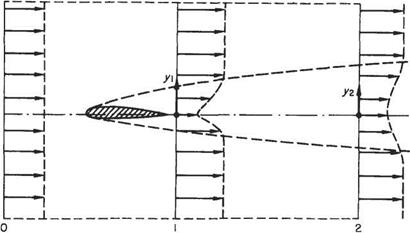Estimation of profile drag from velocity profile in wake
At the trailing edge of a body immersed in a fluid flow, there will exist the boundary layers from the surfaces on either side. These boundary layers will join up and move downstream in the form of a wake of retarded velocity. The velocity profile will change with distance downstream, the wake cross-section increasing in size as the magnitude of its mean velocity defect, relative to free stream, decreases. At a sufficient distance downstream, the streamlines will all be parallel and the static pressure across the wake will be constant and equal to the free-stream value. If conditions at this station are compared with those in the undisturbed stream ahead of the body, then the rate at which momentum has been lost, while passing the body, will equate to the drag force on the body. The drag force so obtained will include both skin-friction and form-drag components, since these together will produce the overall momentum change. A method of calculating the drag of a two-dimensional body using the momentum loss in the wake is given below. The method depends on conditions remaining steady with time.
![]()
|
|

Fig. 7.48











